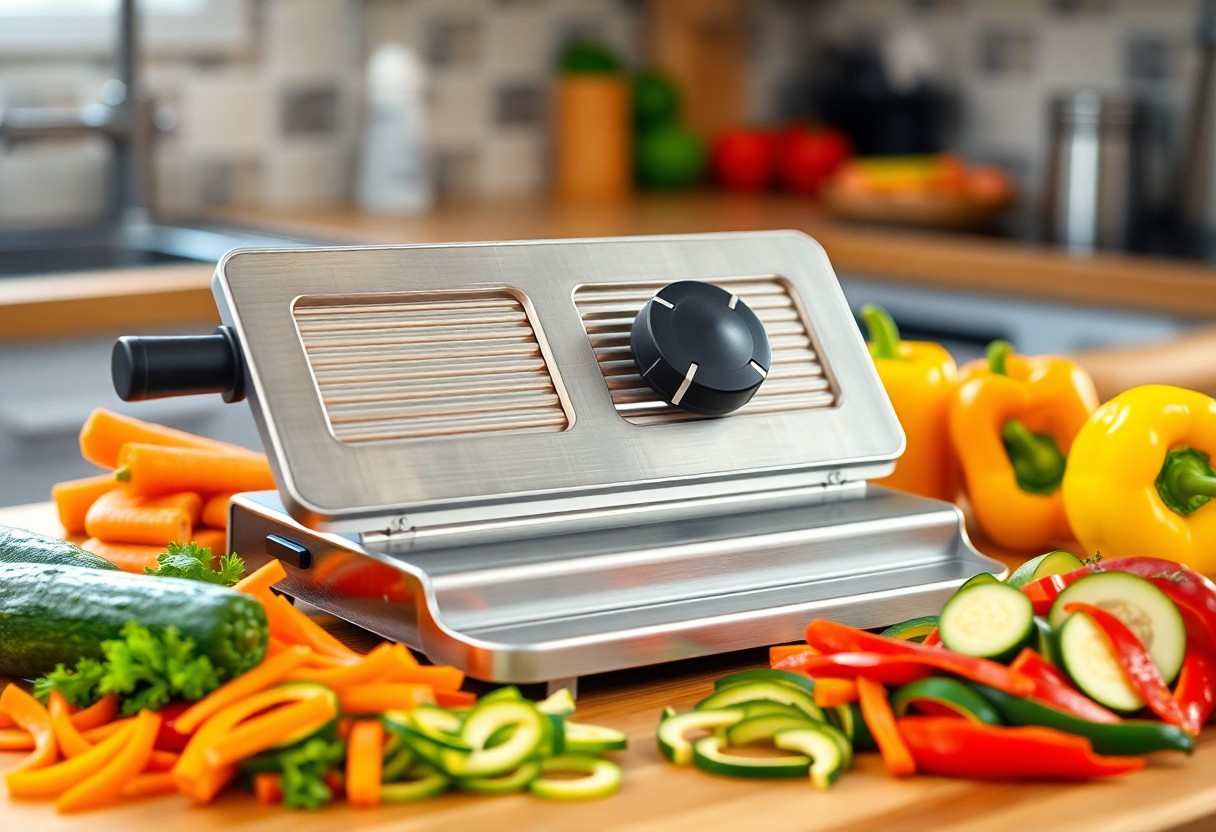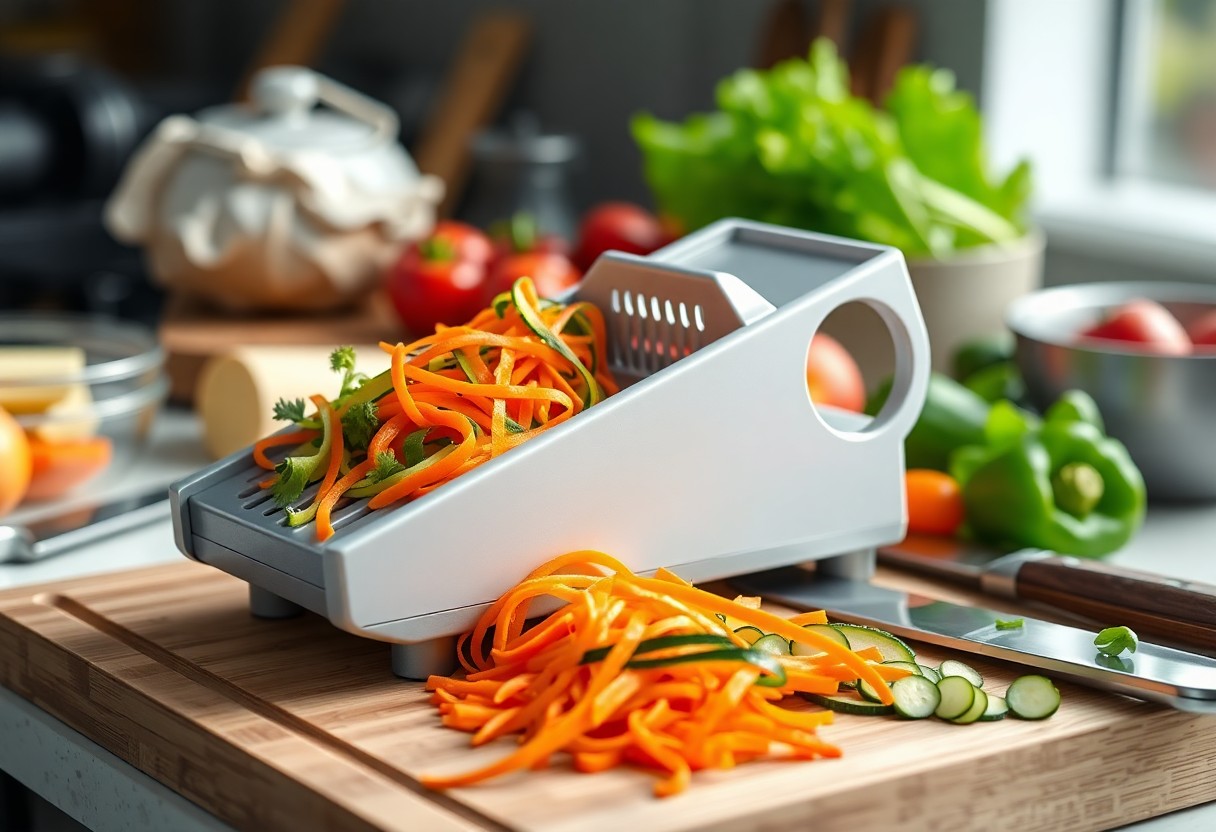Esoteric techniques can transform your culinary skills, especially when mastering tools like the mandoline slicer. In this guide, you will uncover the 7 secrets experts use to create perfect julienne cuts with ease and precision. By following these tips, you’ll elevate your kitchen efficiency and presentation, ensuring every slice enhances your dishes. Prepare to unlock professional-level slicing skills that will impress both family and guests alike.
Understanding the Mandoline Slicer
For mastering the art of julienne cutting with a mandoline slicer, you first need to understand its design and functionality. This kitchen tool features an adjustable blade set that allows you to create uniform slices quickly and safely. Knowing how to adjust and use your mandoline properly will ensure your julienne cuts are consistent and visually appealing, making your dishes look professional and enhancing your cooking experience.
What is a Mandoline Slicer?
If you’ve ever wondered what makes the mandoline slicer a favorite among chefs, it’s the precision it offers. This handheld device uses a flat surface with a sharp blade where you slide vegetables or fruits to achieve perfectly thin, even slices. It comes with different blade attachments to vary thickness and cut styles, such as julienne or waffle cuts, making it an imperative tool for anyone serious about cooking.
Benefits of Using a Mandoline Slicer
Slicer use can dramatically speed up your preparation time and improve the consistency of your cuts. With a mandoline, you avoid uneven slicing, which is common when using a knife. This not only enhances the presentation of your dishes but ensures even cooking, especially important for recipes requiring precise textures. Plus, it minimizes hand strain when cutting large quantities.
Benefits of using a mandoline slicer extend beyond speed and precision. You gain the ability to customize thickness and styles easily, supporting creativity in your cooking. The safety features built into many models also reduce the risk of cutting yourself, giving you peace of mind. By mastering this tool, you elevate the quality and efficiency of your food preparation process significantly.
Essential Features to Look For
Some features of a mandoline slicer can make your julienning experience much easier and more efficient. Features like adjustable thickness, multiple blade types, and a sturdy build ensure precision and safety. When choosing your mandoline, consider aspects that suit your regular slicing needs and ease of cleaning. The table below breaks down five key features and their benefits to help you make an informed decision.
| Feature | Benefit |
|---|---|
| Adjustable Thickness | Allows you to customize slice thickness for different recipes |
| Multiple Blades | Enables cutting styles like julienne, straight, or waffle cuts |
| Non-Slip Base | Keeps the slicer steady for safer operation |
| Safety Guard | Protects your fingers while slicing thin strips |
| Easy to Clean | Saves time during kitchen cleanup |
Different Blade Types
Features of your mandoline slicer include various blade types tailored to your cutting needs:
- Straight blades for uniform slices
- Julienne blades for thin strips
- Crinkle-cut blades for decorative edges
- Waffle blades for textured cuts
Recognizing the blade types your mandoline includes allows you to diversify your culinary presentation and achieve professional results with ease.
Adjustable Thickness Settings
To achieve consistently perfect julienne cuts, you need a mandoline with adjustable thickness settings. This feature lets you control the exact size of your slices, adapting to different vegetables and recipes effortlessly.
Another benefit of adjustable thickness is that it provides versatility beyond julienning. You can slice potatoes for chips, cucumbers for salads, or carrots for soups—all without changing tools. By controlling thickness, you maintain uniform cooking times and presentation quality.
Safety Tips When Using a Mandoline
One of the most common kitchen accidents happens when using a mandoline slicer. To protect yourself, always follow these safety tips:
- Use the hand guard or food holder provided
- Keep your fingers away from the blade
- Slice slowly and with controlled pressure
- Ensure the mandoline is stable before use
- Wear a cut-resistant glove if available
The best way to prevent injuries is to stay focused and never rush while slicing.
Using Hand Guards
Guards are your first line of defense against the sharp blade of a mandoline. Always use the hand guard included with your slicer to hold the food securely and protect your fingers from slipping. This simple step helps maintain control while you julienne, making your slicing safer and more efficient.
Proper Handling Techniques
Handling your mandoline with care means gripping it firmly and positioning yourself comfortably at the work surface. Use slow, deliberate motions to guide the food across the blade, and avoid applying excessive pressure which can cause slips. Keep your non-cutting hand clear of the blade’s path for maximum safety.
Safety also involves ensuring your mandoline is on a stable, flat surface before you begin. Support it with a non-slip mat or damp cloth if needed. Always inspect the blade for sharpness and cleanliness, as dull or dirty blades can increase the chance of accidents. By mastering handling techniques, you protect your hands and improve the quality of your julienne cuts.

How to Prepare Ingredients for Julienne
After selecting your mandoline slicer, such as those featured in the 9 Best Mandoline Slicers of 2023, Tested & Reviewed, it’s important to prepare your ingredients properly. Preparing your vegetables ensures even, precise julienne cuts while enhancing safety and efficiency when using your mandoline. Proper prep sets the foundation for beautiful, professional-looking results every time.
Choosing the Right Vegetables
The best vegetables for julienne cuts are firm and dense, like carrots, cucumbers, zucchini, and bell peppers. These hold their shape well during slicing and provide consistent strips. Avoid overly soft or watery vegetables as they may become mushy and difficult to slice evenly on your mandoline.
Prepping Techniques for Ideal Cutting
Any vegetable you plan to julienne should be washed, peeled if necessary, and trimmed to a manageable size. Cutting the vegetable into flat, stable surfaces will help you maneuver it safely and accurately on your mandoline.
With your vegetables trimmed into uniform sizes, you’ll be able to produce consistent julienne strips that cook evenly and look aesthetically pleasing. Proper prepping also minimizes slipping and ensures better control during slicing, helping you work faster and more safely.

Step-by-Step Guide to Julienne with a Mandoline
Once again, mastering the mandoline slicer for perfect julienne cuts requires precise technique. Use the table below to follow each crucial step clearly and effectively:
| Step | Description |
|---|---|
| Step 1: Set Up Your Mandoline | Adjust blade thickness and secure the mandoline on a stable surface. |
| Step 2: Position Your Ingredient | Place your vegetable correctly using the hand guard or holder to ensure safety. |
| Step 3: Slice with Consistency | Move your vegetable smoothly and evenly across the blade for uniform julienne strips. |
Step 1: Set Up Your Mandoline
The first action you take is to carefully adjust your mandoline’s blade to the julienne setting. Make sure it’s locked firmly in place and place the slicer on a stable, flat surface to prevent slipping while slicing. This setup ensures precision and safety from the very start.
Step 2: Position Your Ingredient
With your vegetable washed and peeled, place it securely in the hand guard or holder provided with your mandoline. Position it so the flat side rests against the slicer surface if applicable, allowing uniform contact with the blade during slicing.
For instance, if you’re slicing carrots, align them lengthwise and firmly clip them into the hand guard to keep your fingers safely away while maintaining optimal pressure for even cuts. Proper positioning leads to clean, equal julienne strips.
Step 3: Slice with Consistency
One smooth and controlled motion is necessary to push the ingredient downwards along the blade. Maintain steady pressure to allow even slicing without forcing or hesitating, which can lead to uneven strips or accidents.
Consistency in your slicing speed and pressure produces uniform julienne pieces, which cook evenly and enhance the presentation of your dish. Take your time to develop a rhythm that feels comfortable and safe for you.
Cleaning and Maintenance Tips
Keep your mandoline slicer in top condition by following these vitals:
- Disassemble carefully to clean all parts
- Use a brush to remove food debris from blades
- Wash with warm, soapy water and dry thoroughly
- Check the manufacturer’s instructions for specific care
Recognizing that maintenance extends the life of your tool, consider investing in quality slicers like the DASH Safe Slice® Mandoline Slicer, Julienne + Dicer for … to ensure reliable performance every time.
Proper Cleaning Techniques
Some proper cleaning techniques will keep your mandoline slicer safe and efficient. After use, disassemble the slicer and gently scrub each part with a soft brush or sponge to remove stuck food without dulling the blades. Avoid abrasive cleaners or scouring pads. Rinse thoroughly with warm water and let all components air dry completely before reassembling to prevent rust or mold buildup.
Storage Tips for Longevity
Any your mandoline slicer should be stored thoughtfully to maximize longevity:
- Keep it in a dry place to avoid moisture damage
- Wrap the blades or use covers to protect them and prevent accidents
- Store components separately if possible to avoid wear
Perceiving that careful storage safeguards your investment, it will ensure the slicer remains sharp and functional.
Techniques for safe and effective storage include:
- Utilizing blade guards or protective sheaths to prevent dulling
- Placing the slicer in a dedicated kitchen drawer or container away from heavy utensils
- Keeping all parts clean and dry before storing to inhibit corrosion
Perceiving that organized storage reduces wear and enhances safety, these steps will help your mandoline slicer last longer and perform better.
Summing up
Summing up, mastering the use of a mandoline slicer to julienne can significantly enhance your kitchen efficiency and presentation. By applying expert techniques such as adjusting the blade properly, ensuring consistent pressure, and using safety guards, you can achieve uniform, professional-quality julienne cuts. With practice and attention to these tips, you’ll confidently prepare vegetables with precision and speed, elevating your culinary skills and making meal prep more enjoyable.

